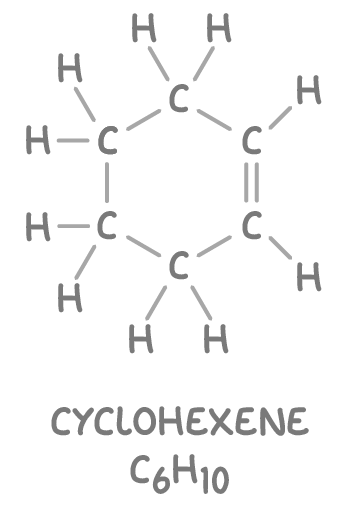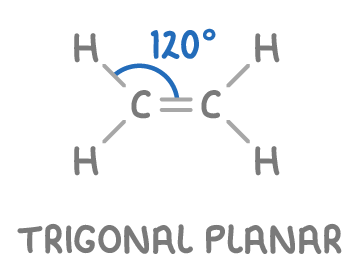The Alkenes
This lesson covers:
- The general formula and bonding of alkenes
- The components of a carbon-carbon double bond
- The trigonal planar geometry of alkenes
- Why alkenes are more reactive than alkanes
- Reactions to produce alkenes
Alkenes have the general formula CnH2n
Alkenes are a class of hydrocarbons containing carbon-carbon double bonds. Their general formula is CnH2n, where n represents the number of carbon atoms.
Key features of alkenes:
- They consist of carbon and hydrogen atoms (hydrocarbons)
- Each alkene molecule contains at least one carbon-carbon double bond.
- Each carbon of the double bond undergoes sp2 hybridisation, where one s orbital and two p orbitals combine to form three equivalent sp2 hybrid orbitals.
- The double bond of alkenes makes them "unsaturated", enabling them to participate in addition reactions.
Examples of alkenes:

Note that cyclic alkenes such as cyclohexene (C6H10) have two fewer hydrogen atoms compared to acyclic alkenes with an equivalent number of carbon atoms.

A double bond consists of a sigma bond and a pi bond
The carbon-carbon double bond in alkenes comprises:
1. A sigma (σ) bond:
- This is a strong bond formed by the head-on overlap of carbon s orbitals.
- It has a high electron density situated directly between the nuclei.
- It is very strong, possessing the highest bond enthalpy among single bonds.

2. A pi (π) bond:
- This bond is created by the sideways overlap of adjacent p orbitals.
- Its electron density is distributed above and below the bond axis.
- It has a lower electron density and bond enthalpy compared to the sigma bond.
- The presence of the pi bond restricts rotation around the C=C bond, as rotation would disrupt the parallel overlap of the p orbitals, leading to a significant increase in energy.

Trigonal planar geometry of carbon in alkenes
In alkenes, each carbon atom within the C=C double bond has:
- Three regions of electron density.
- These regions are arranged in a trigonal planar shape due to equal repulsion between them.
- The bond angles around the carbon atoms are approximately 120°.

An example of this geometry is seen in ethene (C2H4), where each carbon in the double bond displays trigonal planar geometry.
Alkenes are more reactive than alkanes due to their pi bond
Alkanes contain only strong sigma (σ) bonds between carbon atoms, which contribute to their low reactivity. In contrast, alkenes contain a pi (π) bond in their C=C double bond, which makes them more reactive.
The high electron density of the π-bond in the C=C double bond makes the electrons highly accessible for reactions and allows alkenes to readily attract electrophiles.
This structural feature of the pi bond gives alkenes greater reactivity compared to alkanes, enabling them to undergo addition reactions across the C=C double bond.
Reactions to produce alkenes
Alkenes can be produced via several reactions:
- Elimination of HX (where X = Cl, Br, or I) from a halogenoalkane by ethanolic NaOH and heat. For example, bromoethane can undergo elimination to form ethene:
CH3CH2Br + NaOH ➔ CH2=CH2 + NaBr + H2O
- Dehydration of an alcohol by using a heated catalyst (e.g., Al2O3) or a concentrated acid (e.g., concentrated H2SO4). For example, ethanol can be dehydrated to form ethene:
CH3CH2OH ➔ CH2=CH2 + H2O
- Cracking of a longer chain alkane using heat and an aluminum oxide (Al2O3) catalyst. For example, decane can be cracked to form a mixture of smaller alkanes and alkenes, such as hexane and butene:
C10H22 ➔ C6H14 + C4H8